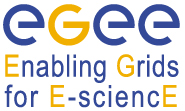Speaker
Report on the impact of the activity, tool or service. This should include a description of how grid technology enabled or enhanced the result, or how you have enabled or enhanced the infrastructure for other users.
Federating medical image repositories is a difficult task since it should be performed without impact on clinical practice. Security, performance and organisational issues have to be taken into account. Data privacy is guaranteed by the pseudoanonimisation and encrypted transmission and storage, and mainly through the fact that only data explicitly shared can be accessed. Performance impact on communications is minimised through the use of distributed storage, which will increase network traffic evenly on the net. Finally, clinical organisation is not adequate for research and training, and content-based organisation improves knowledge discovery. These three issues are mainly achieved through the use of Grid services and technologies.
The key services in the infrastructure, inherited from EGEE, have been the authorisation service and the file transfer. The authorisation service has been extended to deal with encryption and PKI manage multiple administrative domains.
Describe the activity, tool or service using or enhancing the EGEE infrastructure or results. A high-level description is needed here (Neither a detailed specialist report nor a list of references is required).
Sharing and organising medical imaging knowledge is a key issue in medical research and training. Evidence-based medicine is also demanding high-quality well-organised knowledge bases to check for second opinion and drive diagnosis.
However, sharing and organising medical imaging data is not straightforward. Trans-organisational sharing of data and knowledge-oriented organisation of studies is a technological and organisational challenge.
Describe the added value of the grid for your activity, or the value your tool or service adds for other grid users. This should include the scale of the activity and of the potential user community, and the relevance for other scientific or business applications.
TRENCADIS (Towards a Grid Environment for Computing and Sharing DICOM Objects) is a middleware developed to share and organise medical studies and reports based on ontologies constructed upon the fields of structured reports. It is based on an Open Grid Service Architecture implemented on WSRF to organise coding, access rights and data location for different studies and reports.
This platform enables the users to submit new cases which are automatically organised according to the semantic criteria defined through the Virtual Organisations and groups. The platform provides a virtual data catalogue based on the metadata coming from the evaluation report of the radiologists.
It uses VOMS and distributed encryption for the management of the authorisation, DICOM for the coding of the data and metadata of images and structured reports and GridFTP for file transfer.
Abstracts for online demonstrations must provide a summary of the demo content. Places for demos are limited and this summary will be used as part of the selection procedure. Please include the visual impact of the demo and highlight any specific requirements (e.g. network connection). In general, a successful demo is expected to have some supporting material (poster) and be capable of running on a single screen or projector.
Basically, the demo will consist on uploading a (small) DICOM study on the system, writing the DICOM structured report for the semantic annotation, and retrieving images that are alike (in terms of the diagnosis). Images will be shown up to the screen to exemplify how a trainee radiologist could search for additional information to improve or verify his / her diagnosis.
The demo will be supported with a couple of posters describing the architecture and potential features. It will be operated through one laptop connected to a beamer.
The demo will require Internet connection through http, https, GridFTP, FTP protocols and few specific ports open. It will connect to an infrastructure comprised of several TRENCADIS DICOM storage elements and the application servers. The bandwidth should be wide enough to transfer a few megabytes up and down in a few seconds (wired connection preferred).
